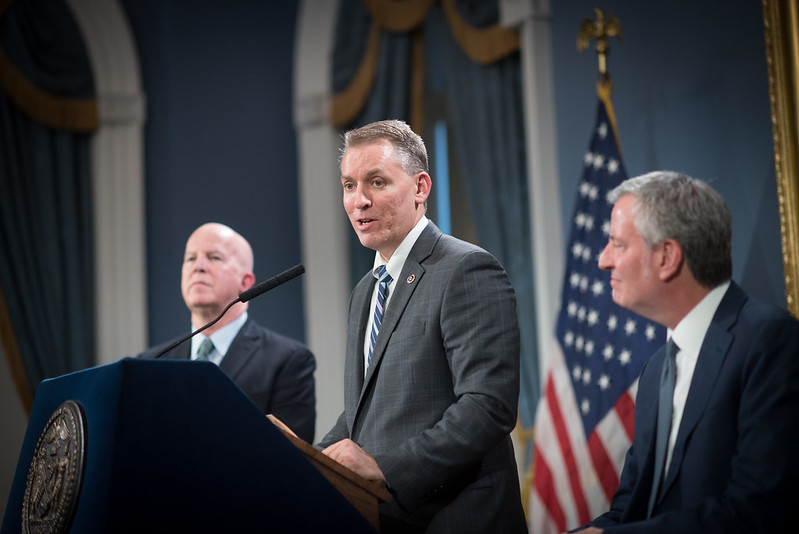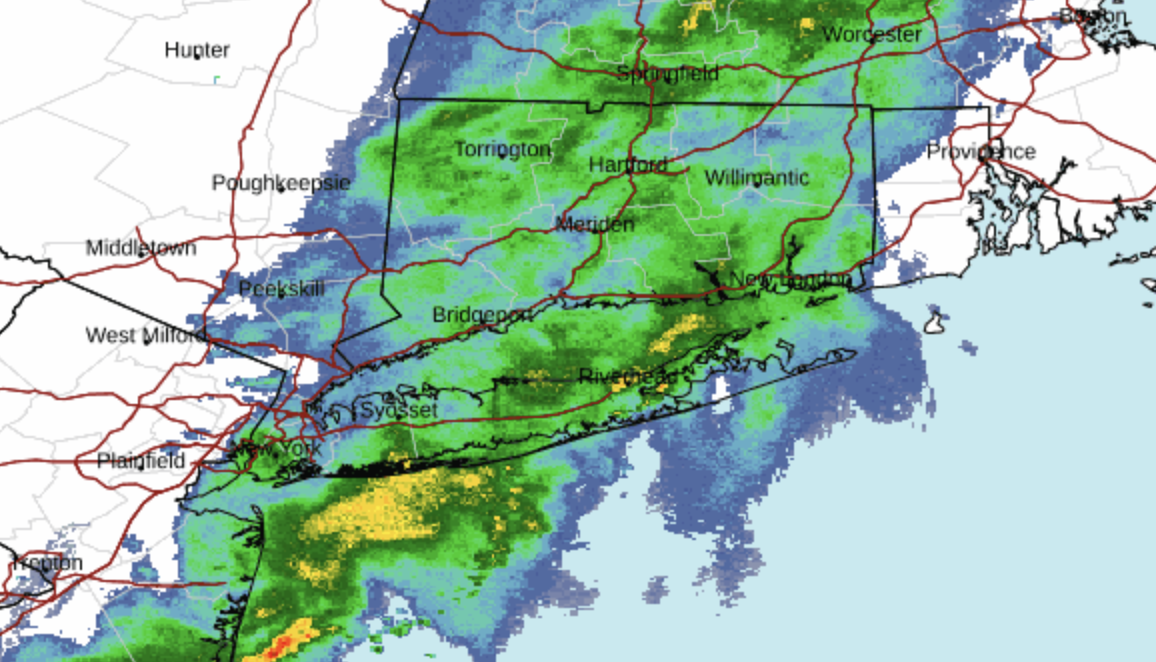It's a new day in New York policing, as No Bell Prize-winning Commissioner James O'Neill is stepping down from his position. O'Neill is being replaced by NYPD Chief of Detectives Dermot Shea, a veteran cop and Sunnyside native who will have a lot on his plate — including, it turns out, a whole host of asks from #bikenyc.
Cyclists and the police haven't had a historically great relationship, what with the Critical Mass bodyslams, the parking in bike lanes, the victim blaming, the indifference to investigation, and the harassment of young people of color. But new leadership is a chance for a fresh start, so with that in mind, here's what the city's cycling community hopes will change under Commissioner Shea's leadership:
1. All collision investigation reports released to the public within six months: All too frequently, the last thing the public hears about fatal crashes is that the driver escaped culpability after a police investigation. What happened during the investigation? Who did the police talk to and what factors, such as speeding or driver distraction, did cops take into account while working through their crash study? New Yorkers never find out, whether it's cases when witnesses report a driver blowing a light or a case in which an SUV driver inexplicably plows onto the sidewalk, and as a result we can't learn how to make crash investigations work better.
2. No unauthorized NYPD versions of crash cause: Of course, this information deficit around crashes never seems to extend to the immediate aftermath of the collisions, when police officers are willing to tell reporters almost anything that exonerates drivers (who are often the only witness interviewed by police at the scene). No more anonymous police officials excusing hit-and-run drivers by telling reporters the driver probably didn't see their victims, no more suggesting cyclists just fell off of their bike out of the blue before they were run over.
3. Take the Collision Investigation Squad expansion money: You're more likely to be killed by a car or truck than by a gun in modern-day New York City. And yet despite the fact that vehicles are such a danger on the road, the Collision Investigation Squad remains a tiny 26-person team that investigates only a tiny fraction of the tens of thousands of injury-causing crashes each year. Nonetheless, O'Neill still said that he wasn't interested in accepting millions from the City Council to hire 15 more detectives for the division. If 45,000 injury-causing crashes aren't enough to encourage the NYPD to beef up its CIS, what's it going to take? Fifty-thousand crashes? Seventy-five thousand?
4. A five-fold increase in cops patrolling outside of NYPD vehicles: Seeing the city from a car is scientifically proven to warp your brain in such a way that you only wind up caring about the complaints of drivers. Look at what happened to the mayor, who's suffering from a terminal case of SUV brain. To prevent this awful malady, we want five times as many officers who currently drive their beat to either walk it or bike it. If you want to see what life is like for cyclists out there, take Transportation Alternatives up on their offer of a bike ride. Here's a bonus: Get cops out of cars and you'll wind up with fewer bad publicity hits like an officer parked in a bike lane taunting a cyclist over his PA.
5. No bike ticketing traps: Cyclists received 22 percent of tickets for running red lights in 2019, even though drivers do a disproportionate amount of damage. The NYPD can only rack up that many tickets against bicyclists through frequent ticket traps that ensnare cyclists even if there's no traffic or pedestrians around them. "Cyclists are not the big issue on red lights," said Council Member Donovan Richards.
6. Quit the e-bike crackdown: What do pictures of NYPD officers smiling next to dozens of seized e-bikes accomplish exactly? The police department has gleefully jumped at the occasion to bust delivery riders on e-bikes in the name of public safety, and they've done such a good job of it that traffic fatalities are ... up 170 percent for cyclists and 7 percent for pedestrians this year compared to the same period in 2018. Rather than make the streets actually safer, the e-bike crackdown is only punishing the city's lowest-paid workers, who are trying to do a job mostly required by the wealthy. So please, Commissioner-designate Shea, ignore the mayor's wrongheaded insistence that the bikes are a huge danger on the street — in fact, as Streetsblog reported, e-bikes account for mere hundredths of one percent of all the 45,775 injury-causing motor vehicle collisions in 2018. And of the 11,115 pedestrians who were injured in 2018, just nine of them were struck and hurt by an e-bike rider, the statistics show. That’s .08 of a percent.
7. Full implementation of right-of-way law charges): Transportation Bureau Chief Thomas Chan told the City Council that the NYPD has written 34 percent more failure to yield tickets to drivers in 2019 when compared to 2018. But a City Limits investigation also found that drivers are escaping with small tickets instead of any kind of real sanctions, in part because the officers writing the summonses are bungling the initial summons or just blowing off the hearings that take place after the tickets are written. If the NYPD is going to show it actually cares about dangerous driving, it has to see the sanctions all the way through.
8. All precincts must show a 10-percent drop in serious injury- or fatality-causing crashes each year: The city's Department of Transportation doesn't have a good formula for what they're doing in Priority Bicycle Districts, the community boards where cyclist deaths and severe injuries are at their highest. Here's a chance for you to show some leadership on the issue then, and demand the precincts under your command lower their "killed or seriously injured" number by 10 percent every year, starting next year. All it takes is a commitment from the officers in each precinct to crack down on speeding, reckless driving and failure to yield, all of which are otherwise known as "doing crimes."
9. Get your own reckless officers off the road: Speaking of crimes, commish, have you taken a look at the driving records of your own officers? Streetsblog has and we've found hundreds of police with dozens of tickets from the city's automated enforcement cameras. You know as well as we do that these aren't cops just driving a mile or two per hour over the speed limit, these s-cop-laws are driving at least 11 miles per hour over the speed limit or carelessly running red lights. That's reckless behavior that puts cyclists, pedestrians and other drivers at risk, and it's the lowest-hanging fruit of street safety. Hand out some suspensions, hand out some desk duty, take away some vacation time — just do something that shows us you care about moving violations coming out of your own police force. Besides, all cops get free use of subways and buses, a nice perk that all too few cops use.
10. A real crackdown on parking in bike lanes. And on sidewalks. And placard abuse: Taking the hammer to the sidewalk parkers, the bike lane blockers, the placard abusers among the NYPD has been nothing but an April Fool's Day fantasy in the city. But it doesn't have to be this way! Like the very real evidence of dangerous drivers among the police force, people find pictures of the NYPD parking in bike lanes every goddamn day. There's an entire Twitter account devoted to documenting the impunity of placard abusers around the city. Everyone knows this is a problem and all we get are lame excuses and deflections from the likes of Chief Chan, who swears that he's always talking about this with precinct commanders. "It’s hard to get to the right thing until you stop doing the wrong thing," said Jon Orcutt of Bike New York. "Police simply not obstructing bike routes would constitute major progress in 2020-2021."
Honorable mention: Fight to get cops to live in the city they serve: All of the requests on this list are crucial, but all of them would be far easier to achieve if cops were actually forced to live in the five boroughs — though, currently, 51 percent of them have exiled themselves to places where they feel more comfortable. If high housing costs are an issue, cops could get their union to demand a housing stipend. But think of how much better officers your rank-and-file would be if they actually knew the communities and the people they are sworn to protect and serve? Wouldn't they be better neighborhood officers if they lived in the neighborhood — like you did, former Officer Shea?






